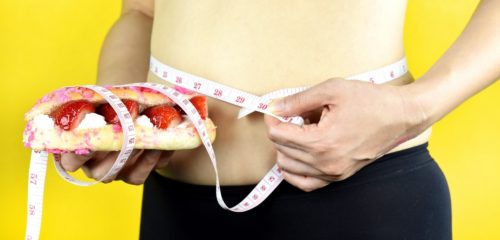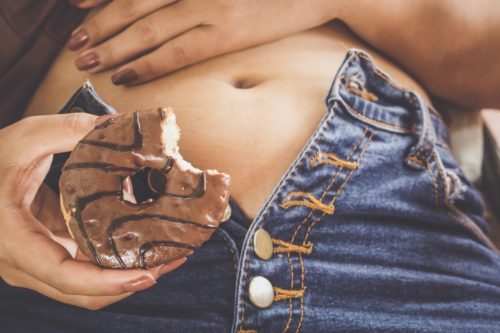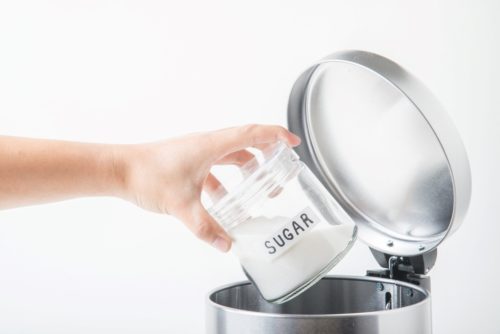
Sugar is notorious for causing belly fat. That’s a simple rule that you have to learn and learn to accept even though it’s not so convenient when you’re craving a double chocolate donut!
When our jeans fit too tight in the waist to be comfortable, we all lament about our belly fat. But… what exactly are we talking about when we say “belly fat?”
It turns out that when the circumference of your waist expands, it can be caused by TWO different layers of fat:
- The subcutaneous layer of fat embedded just below the inner layer of belly skin. This is the fat that you can actually pinch, along with your loose belly skin.
- The visceral fat that is surrounding all the visceral organs like the liver, pancreas, stomach, and intestine. This layer of fat is hidden under the abdominal cavity so you cannot pinch it.
When Santa Claus shouts “Ho Ho Ho!” and his belly jiggles and wiggles like a bowl full of jelly, that’s the subcutaneous fat in his belly doing all that jiggling. Visceral fat doesn’t jiggle. In fact, you can have a rock-hard belly that is just loaded with thick layers of visceral fat.
Both types of belly fat affect our waist circumference but the lumpy fat you actually see in the mirror is the subcutaneous fat. When you see your belly start to protrude out but you can’t pinch it, that can be a sign that your visceral fat is growing.
Although it may not look as “ugly,” visceral fat is far more dangerous than subcutaneous belly fat because it interferes with the function of your visceral organs. It can prevent your liver from producing bile, thereby interfering with the breakdown of fat. Your liver also works hard to eliminate waste. When your organs are enveloped with fat, that can prevent your pancreas from sending out hormones like insulin when they’re needed most. It can raise your cholesterol, raise your blood pressure, and increase your risk for breast cancer and colon cancer.
I’m trying to make this distinction between the two types of belly fat as clear as possible because I want to tell you about a very intriguing study that was done comparing the differences between fructose and sucrose (table sugar) on the deposition of belly fat (among other things like insulin resistance).
You’d think that both of these common dietary sugars would have the same effect on belly fat, right?
If you answered, “yes,” you’re wrong. There WAS a difference and a very significant difference at that.

Care to guess which type of sugar, fructose or sucrose, caused the belly fat to grow more?
If you answered, “fructose,” you’d be right.
HOWEVER, you’d also be right if you answered “sucrose!”
What? How can both of these answers be right?
As the old expression goes, “the devil is in the details.” Both answers are right because it depends on which type of belly fat you’re talking about!
Fructose made people gain more weight and volume in their visceral fat. Sucrose made people gain more weight and volume in their subcutaneous fat.
So, there’s a significant difference in how fat is deposited around your middle when you consume fructose versus sucrose!
Isn’t that fascinating!? And perhaps a very practical thing to know…. remember, visceral fat is more dangerous for your health even though it may not look as bad as the lumpy subcutaneous fat.
However, both types of fat are bad for you as the subcutaneous fat releases more harmful substances into your bloodstream than the visceral fat. These harmful substances constantly shout “Inflammation!” to get your immune system into the fighting mode. And this fighting mode continues until you’ve lost that excess belly fat. Sounds like a good reason to quit sugar!
Before you ask, the study was done on both men and women and both showed this same difference in fructose versus sucrose in laying down fat around the middle. In the men, it was slightly more pronounced but not by much. Women can get “beer bellies” too… and they can get “sugar bellies” just like men too.
These experiments were conducted with a control group plus one experimental group who drank fructose shakes with their meals and second experimental group that drank sucrose shakes with their meal. Both shakes provided the participants with 25 % of their energy needs. This intriguing study went on for eight weeks. It was conducted by a group of scientists at the University of California at Davis.
The visceral fat was measured by computerized tomography which uses x-ray technology to take pictures of what’s inside so the results for visceral fat should be quite accurate.
If you would like to read this article for more details, the full article is available online. The article is entitled “Consuming fructose-sweetened, not glucose-sweetened, beverages increases visceral adiposity and lipids and decreases insulin sensitivity in overweight/obese humans.”

Please note that “visceral adiposity” means visceral fat (that is, belly fat). You should also note there was a corresponding decrease in insulin sensitivity which means there would have been a rise in the blood glucose. Thus, the sugar that they consumed had a two-pronged effect of increasing visceral fat around the vital organs and raising blood sugar… a big time double whammy!
Consuming too much sugar can be just as dangerous as taking drugs or drinking alcohol.
However, the sugar-free keto-vegan lifestyle is a perfect way to lose not only subcutaneous belly fat but also the dangerous visceral fat.
The next time you’re doing sit-ups and complaining that you can still pinch the fat between your fingers, just remember that you may be losing fat you can’t even see in your visceral cavity… and it’s the visceral fat, the most dangerous kind of belly fat!

Leave a Reply
You must be logged in to post a comment.